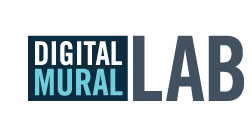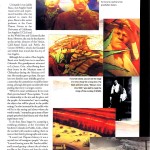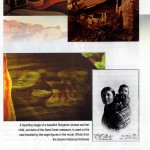BY GARY WALKER

The mural community received what many feel was a bittersweet victory on
February 19th, when the Los Angeles Planning Commission voted to view
murals and signs as separate objects, a position that artists have been
arguing for nearly a decade.
But their hopes that these artistic expressions would be incorporated into a new sign ordinance were
deflated when the commission voted to include murals in the new law
only after a number of other concerns about the proposed ordinance were
addressed.
“The distinction between murals and signs is simple;
it’s the intent,” said Judith Baca of the Social Art and Public
Resource Center (SPARC), a Venice-based nonprofit arts center that
produces and preserves public art. “If it’s about beauty or social
interaction, it’s a mural. If it’s designed to sell a product, then
it’s advertising, pure and simple.”
The proliferation of super graphics and outdoor advertisements have far
outpaced murals over the last ten years, a fact that causes artists like Baca great distress.
“Large parts of our city’s legacy are being forgotten or damaged by graffiti,
and as we lose these murals, we lose a part of ourselves,” said Baca,
SPARC’s founder.
The arts center has launched an initiative called the Mural Rescue
Program that began in February to drawattention to how murals have
become an afterthought to city officials and to resurrect the public’s
interest in the importance of these social art pieces.
According to Baca, each year, several murals
are painted over by city agencies or defaced by graffiti artists.
Contractors hired by the city government to remove “tagging” from city
property often damage murals, due to the chemicals that are used, and
the protective coating on murals is often damaged. In other cases,
SPARC representatives say that many murals are being painted over to
make room for super graphics and commercial art, which generates large
sums of revenue for municipal coffers.
“We are witnessing a massive corporatization of the public space,” said Baca.
Ava Porter, a photographer at SPARC, has a large role in the arts center’s
quest to preserve the remaining murals throughout the city, including
those in Venice, long considered a haven for artistic expression.
“The county and the city spend almost $70 million a year on graffiti
abatement and almost nothing on arts education,” Porter, a former
student of Baca’s at UCLA, pointed out. “The two things are not
mutually exclusive, and what we want to do is create a program to save
our remaining murals.”
The campaign’s Web site, SaveLAMurals.org/, gives an overview of its
plan to save the 105 murals that have been painted in Los Angeles over
the last three decades, many of them by disciples of Baca.
“Now is the time to turn hope into action by encouraging city officials
to reallocate a percentage of graffiti abatement monies to a Mural Rescue
Program and to save Los Angeles’ legacy of public murals,” the Web site states.
Porter says that this initiative can bring an added bonus.
“This is another way to employ youth as well and to educate them about the
importance of murals, and redirect youth that might be tagging,” she
said.
The Web site has had nearly 1,000 hits thus far, say SPARC
officials, and Baca says that the campaign has progressed better than
she had hoped.
“I think that it has been incredibly successful,
given the comments that we’ve received,” she said. “It really speaks to
the relationship between murals and the city.”
The plan to rescue artwork with social, historical and political content is being
conducted against the backdrop of another campaign being waged by
artists at City Hall.
Following a unanimous vote in December by the Los Angeles City Council
to place a three-month ban on commercial billboards and graphics,
the Planning Commission was instructed to review the city policy that
not only has disallowed murals nearly a decade, but views the distinct
art form the same as commercial signage.
“At the moment, there is no process for the permitting of murals,” Pat
Gomez, murals manager of the Department of Cultural Affairs, confirmed.
Muralists who feel that their unique artistic expressions have long been
suppressed in favor of commercial advertising are planning a full-court
press to influence the commissioners following the council’s moratorium
on billboards, and many see the consideration of a new sign ordinance
as an opportunity to resuscitate an artform that they feel has been
muted by city officials for far too long.
Supporters of public art came away pleased that the commission agreed
to acknowledge the distinction between murals and signs, but lamented
the decision to delay action on incorporating this provision into a
new ordinance until other matters are fully discussed.
“This means that we will have to wait that much longer to get an
ordinance that will allow for any form of a legal mural,” said Stash Maleski,
the director for In Creative Unity Art, a Venice-based art production
company specializing in murals.
Maleski was heartened by the commission’s decision to
work with the Cultural Affairs Commission and the Department of
Cultural Affairs to craft a future plan for murals.
“These are the appropriate city agencies to deal with issues of art and culture,” Maleski said.
William Caperton y Montoya, the director of marketing and development for the
Department of Cultural Affairs, indicated in a previous interview that
his agency has artists’ best interests in mind and looks forward to
working on the mural plan.
“We view murals as an artistic asset and we consider Los Angeles
to be the mural capital of the world,” Caperton y Montoya said.
“The department has the interests of the artists first and foremost,
and we want to do all that we can to make sure that these fine arts
murals do not disappear.”
While she believes that drawing the important difference between
commercial signs and murals is critical, Baca feels that the debate
is largely a distraction from what is really more pressing, which is the
preservation of these visual social commentaries.
“I don’t want to be distracted from the important issue, which
is the restoration of public art,” said SPARC’s founder.
“Public art is disappearing at an alarming rate and a generation
of young people will soon have not had the opportunity to work
on or see these murals.”
The commission will revisit incorporating murals into the new sign ordinance over the next several weeks.
Gail Goldberg, the director of the Planning Department, did not return calls for comment at Argonaut press time.
























